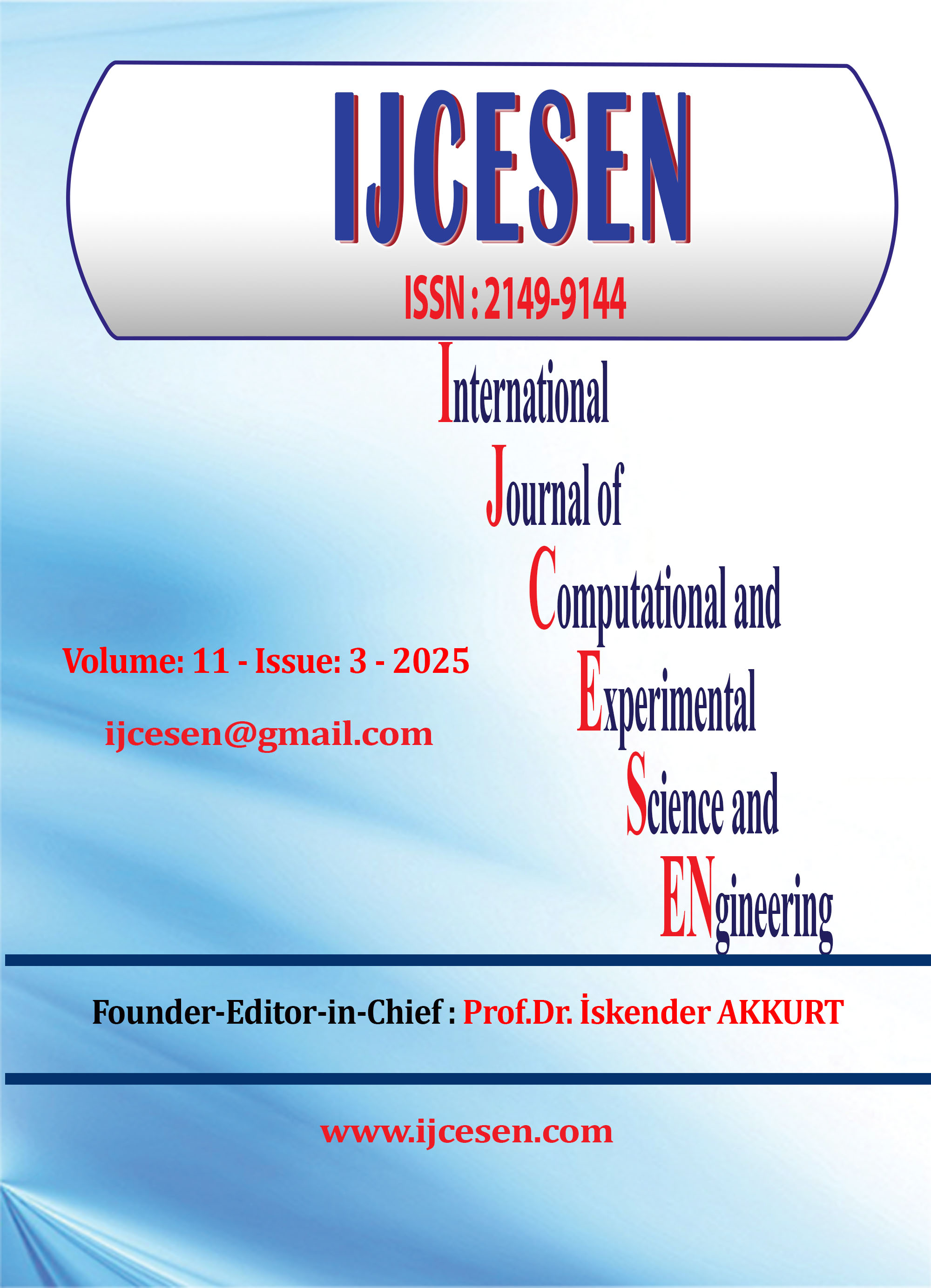Hybrid Optimization of Logistic Regression for Water Footprint Modeling in Iraqi Agriculture
DOI:
https://doi.org/10.22399/ijcesen.3616Keywords:
Water footprint prediction, Logistic regression, RFE, SMOTE, Feature scaling, cross-validationAbstract
Water scarcity in Iraq underscores the urgent need for accurate water footprint (WF) prediction to support sustainable agricultural practices. This study presents an enhanced logistic regression (LR) model for WF forecasting by incorporating Recursive Feature Elimination (RFE), Synthetic Minority Oversampling Technique (SMOTE), and data normalization. RFE was employed to identify the most influential predictors, while SMOTE effectively addressed class imbalance within the dataset. Standard scaling was applied to stabilize model performance across varying data magnitudes. The model was evaluated using time-series cross-validation to ensure robustness and prevent data leakage, achieving a high predictive accuracy of 98.22%. The proposed framework offers a reliable tool for forecasting WF trends in Iraq over the period 2025–2030, contributing to evidence-based water resource management in arid agricultural regions.
References
[1] B. H. Al-Badri, M. K. Mohammad, and J. O. Khalid, “The Water Footprint and Virtual Water and Their Effect on Food Security in Iraq,” IOP Conf. Ser. Earth Environ. Sci., vol. 1222, no. 1, 2023, doi: 10.1088/1755-1315/1222/1/012023.
[2] S. H. Ewaid, S. A. Abed, and N. Al-Ansari, “Water footprint of wheat in Iraq,” Water (Switzerland), vol. 11, no. 3, pp. 1–12, 2019, doi: 10.3390/w11030535.
[3] A. De Mauro, A. Sestino, and A. Bacconi, “Machine learning and artificial intelligence use in marketing: a general taxonomy,” Ital. J. Mark., vol. 2022, no. 4, pp. 439–457, 2022, doi: 10.1007/s43039-022-00057-w.
[4] S. Isak-Zatega, A. Lipovac, and V. Lipovac, “Logistic regression based in-service assessment of mobile web browsing service quality acceptability,” Eurasip J. Wirel. Commun. Netw., vol. 2020, no. 1, 2020, doi: 10.1186/s13638-020-01708-2.
[5] K. D. Aashu Katharria, Kanchan Rajwar, Millie Pant, Juan D. Velásquez, Václav Snášel, “Information Fusion in Smart Agriculture: Machine Learning Applications and Future Research Directions,” arXiv Prepr. arXiv2405.17465, 2025, doi: 10.48550/arXiv.2405.17465.
[6] T. Park and C. Kim, “Predicting the variables that determine university (Re-)entrance as a career development using support vector machines with recursive feature elimination: The case of South Korea,” Sustain., vol. 12, no. 18, 2020, doi: 10.3390/SU12187365.
[7] J. Hemmatian, R. Hajizadeh, and F. Nazari, “Addressing imbalanced data classification with Cluster-Based Reduced Noise SMOTE,” PLoS One, vol. 20, no. 2, p. e0317396, 2025, doi: 10.1371/journal.pone.0317396.
[8] M. Bhagat and B. Bakariya, “A Comprehensive Review of Cross-Validation Techniques in Machine Learning,” vol. 16, no. 1, pp. 1–4, 2025.
[9] M. Emeç, A. Muratoğlu, and M. S. Demir, “High-resolution global modeling of wheat’s water footprint using a machine learning ensemble approach,” Ecol. Process., vol. 14, no. 1, 2025, doi: 10.1186/s13717-025-00594-0.
[10] F. Mortazavizadeh et al., “Advances in machine learning for agricultural water management: a review of techniques and applications,” J. Hydroinformatics, vol. 27, no. 3, pp. 474–492, 2025, doi: 10.2166/hydro.2025.258.
[11] A. M. Abdel-Hameed et al., “Estimation of Potato Water Footprint Using Machine Learning Algorithm Models in Arid Regions,” Potato Res., vol. 67, no. 4, pp. 1755–1774, 2024, doi: 10.1007/s11540-024-09716-1.
[12] Shaik Mabasha, “Evaluating the machine learning based Efficacy of Decision Tree and Support Vector Machines in Smart Irrigation Systems for Precise Irrigation Status Classification for Optimizing Water Management in Agriculture,” J. Electr. Syst., vol. 20, no. 2s, pp. 867–875, 2024, doi: 10.52783/jes.1682.
[13] R. H. Al-Taher et al., “Predicting Green Water Footprint of Sugarcane Crop Using Multi-Source Data-Based and Hybrid Machine Learning Algorithms in White Nile State, Sudan,” Water (Switzerland), vol. 16, no. 22, 2024, doi: 10.3390/w16223241.
[14] Ruchira C. Mahore and Naresh G. Gadge, “Design A Model for Crop Prediction And Analysis Using Machine Learning,” Int. J. Sci. Res. Comput. Sci. Eng. Inf. Technol., vol. 3307, pp. 90–95, 2023, doi: 10.32628/cseit228681.
[15] F. Hina and M. T. Hasan, “Agriculture Crop Yield Prediction Using Machine Learning,” no. April, 2022.
[16] Ashwini I. Patil, R. A. Medar, and V. Desai, “Crop Yield Prediction Using Machine Learning Techniques,” Int. J. Sci. Res. Sci. Eng. Technol., vol. 7, no. 3, pp. 312–315, 2020, doi: https://doi.org/10.32628/IJSRSET20736.
[17] S. Sadri, J. S. Famiglietti, M. Pan, H. E. Beck, A. Berg, and E. F. Wood, “FarmCan: a physical, statistical, and machine learning model to forecast crop water deficit for farms,” Hydrol. Earth Syst. Sci., vol. 26, no. 20, pp. 5373–5390, 2022, doi: 10.5194/hess-26-5373-2022.
[18] O. Mialyk, J. F. Schyns, M. J. Booij, H. Su, R. J. Hogeboom, and M. Berger, “Water footprints and crop water use of 175 individual crops for 1990–2019 simulated with a global crop model,” Sci. Data, vol. 11, no. 1, pp. 1–16, 2024, doi: 10.1038/s41597-024-03051-3.
[19] Google Earth Engine, “Google Earth Engine.” Accessed: Oct. 15, 2024. [Online]. Available: https://earthengine.google.com/
Downloads
Published
How to Cite
Issue
Section
License
Copyright (c) 2025 International Journal of Computational and Experimental Science and Engineering

This work is licensed under a Creative Commons Attribution 4.0 International License.





